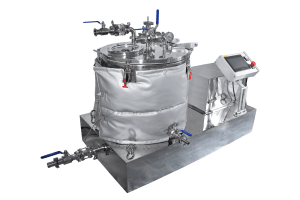A centrifuge is a machine to separate the components of a mixture based on density or particle size by utilizing an applied centrifugal force field. It is initially used for separating the compositions of milk, and now expands into the scientific, medical and other fields. It can be said that there are a great number of purposes of using a centrifuge.
Types of Centrifuges

Generally, centrifuges can be classified from following aspects:
- In terms of purposes, centrifuges can be classified into preparative centrifuges and analytical centrifuges.
- According to rotating speeds, centrifuges can be divided into low speed centrifuges, high speed centrifuges and ultrahigh speed centrifuges.
- Based on the requirements for temperature, there are two main types of centrifuges, which are general centrifuges and refrigerated centrifuges respectively.
- As rotors are different, centrifuges can be classified into horizonton centrifuges and angle rotor centrifuges.
- As well, centrifuges can be divided into ground type centrifuges, desktop centrifuges and palmtop centrifuges according to the volume of centrifuges.
While there are a great variety of centrifuges available, all of them works on the principle of sedimentation which causes denser substances to separate from less dense ones.
Purposes of Centrifuges
Due to so many types, there are a multitude of uses or applications of centrifuges.
Generally, a centrifuge is an essential equipment that can be used to separate liquid and solid particles or liquid mixture with liquid components by making using of the centrifugal force.
Speaking specifically, centrifuges are mainly used to separate liquid and solid particles in the suspension or separate immiscible liquids with different densities in the emulsion. As well, centrifuges can be adopted to extract liquid from the wet solid. For example, a washing machine is used to dry wet clothes. The special ultra-velocity tube centrifuges can be used to separate gas mixtures of different densities. Due to solid particles of different densities or sizes in liquid features various sedimentation speed, some centrifuges can classify solid particles according to densities or particle sizes.
As we mentioned above, centrifuges can be widely applied in a great number of fields. Hence, let’s go through the specific purposes of a centrifuge together next.
In the pharmaceutical industry
The low-speed centrifuge is already available throughout the pharmaceutical industry. The low-speed centrifuge and small scale centrifuge of about 3000 rpm for blood separation constitutes the entire low-speed industrial centrifuge system.
In the chemical laboratory
In chemical lab, the centrifuge is mainly used to separate, define and extract biologic substances samples. The low-speed centrifuge is mainly used for the precipitation and collection of cells, nuclei, and cell membranes. The high-speed centrifuge is mainly used to prepare and collect microorganisms, cell debris, large organelles, and so on. The ultra-high speed centrifuge is mainly used to separate, purify, identify and analyze mitochondria, microsomes, chromosomes, lysosomes, plasmids, macromolecular nucleic acids, and high molecular proteins.
In the food processing field
The centrifuge is also used in food-processing field. It is used for milk separation, textile dehydration and dehydration of crystal sugar in sugar refineries. Besides these, people also use small scale centrifuge in their own home.
In the field of coal chemical
In the field of coal chemical, after the desulfurization and deamination of the coke oven gas by centrifuge, it can be used as a steelmaking fuel.
[title text=”Related Products” tag_name=”h2″ color=”rgba(32, 163, 219, 0.81)”]
[ux_products columns=”3″ ids=”3901,2110,2852″]
[title text=”Related Posts” tag_name=”h2″ color=”rgba(32, 163, 219, 0.81)”]
https://www.rotovap.cn/blog/5997.html
https://www.rotovap.cn/blog/5981.html
https://www.rotovap.cn/blog/5987.html
